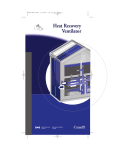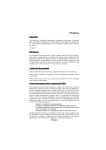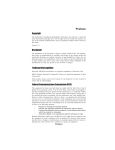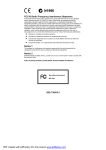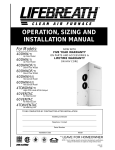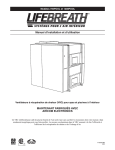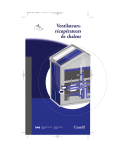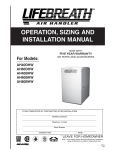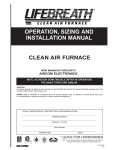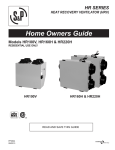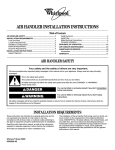Download Venmar HRV 2500 Owner`s manual
Transcript
Operating and Maintaining your HRV Page 1 of 1 ISBN 0-662-26591-2 Cat. no. M91-23/8-1998E Table of Contents Introduction Section 1 Section 2 Section 3 Section 4 Section 5 Section 6 Section 7 The Need for Mechanical Ventilation The HRV System Operating Your HRV Routine Maintenance HRV Maintenance Chart Operating Problems and Solutions Other Sources of Information Issued also in French under title: Guide d'utilisation et d'entretien des ventilateurs–récupérateurs de chaleur (VRC) Next Section http://oee.nrcan.gc.ca/publications/infosource/pub/home/Operating_and_Maintaining_your_ 01/24/2003 Operating and Maintaining your HRV - Introduction Page 1 of 1 Introduction The importance of ventilation in today’s more energy-efficient homes is universally recognized. Introduced as a requirement for airtight R-2000 Homes, continuous ventilation systems are now common in new conventional housing and major home renovations. Because of the energy savings generated, the system of choice is often a heat recovery ventilator (HRV). An HRV is a mechanical ventilation device that helps make your home healthier, cleaner and more comfortable by continuously replacing stale indoor air with fresh outdoor air. HRVs are set apart from other mechanical ventilation devices by their ability to exchange heat between the supply and exhaust air streams, which in turn reduces the cost of heating or cooling the healthy fresh air that circulates through the home. HRVs are sometimes called air-to-air heat exchangers because they preheat or cool incoming air using exhaust air. This booklet discusses the need for mechanical ventilation in today’s homes and explains the components of an HRV system, how to operate and maintain the system, and how to solve operating problems. This information will be of use to occupants of homes with HRVs. There are many types of HRVs on the market, as well as different installation strategies. The size of your house, type of heating system, and geographical location, etc. can all affect the kind of system you have and the way it has been installed. The diagrams in this booklet give examples of some of the types of systems available; they are provided for information purposes only. This booklet is intended to supplement your HRV owner’s manual, not to replace it. If you need a manual or more information on operating procedures for your HRV, contact the installer or manufacturer. Click here for a list of HRV manufacturers whose products have certified performance ratings from the Home Ventilating Institute. Table of Contents | Next Section http://oee.nrcan.gc.ca/publications/infosource/pub/home/Operating_and_Maintaining_your_ 01/24/2003 Operating and Maintaining your HRV - The Need for Mechanical Ventilation Page 1 of 4 The Need for Mechanical Ventilation Cleaning the Air in an R-2000 Home R-2000 Homes are built to be extremely airtight. This limits the uncontrolled flow of air in and out of the home and greatly reduces heat loss and moisture damage to the building structure. To complement this airtightness and ensure a healthy living environment, R-2000 Homes use a mechanical ventilation system to remove pollutants from the home by replacing stale indoor air with fresh outdoor air. These pollutants come from a wide range of sources—household contents and materials, people and their activities as well as family pets (see Some Typical Household Pollutants). In most R-2000 Homes, the preferred mechanical ventilation system is an HRV. This system allows fresh air to be distributed throughout the house. A properly installed, operated and maintained HRV exhausts indoor air pollutants and excess humidity to the outdoors while distributing fresh air throughout the house. During the heating season, the HRV captures heat from the outgoing air and uses it to preheat the incoming fresh air. During the air-conditioning season, an HRV can reverse this heat-exchange process, removing some of the heat from the incoming air and transferring it to the outgoing air. Cleaning the Air in a Conventional Home In recent years, more and more existing homes have undergone energy-efficiency improvements such as upgraded insulation, improved air sealing, the installation of energy-efficient windows, doors and heating systems, etc. As well, improved practices in new home construction have resulted in more energy-efficient and airtight conventional homes. In many of these homes, air infiltration through doors, windows and other openings in the building shell is too random and does not always provide adequate ventilation, which is just as important in a conventional home as in an R-2000 Home. Even when there is an acceptable rate of air exchange, the fresh air may not be getting to the rooms where it is needed. As a result, mechanical ventilation is needed in many conventional homes in order to evenly distribute fresh air throughout the home and maintain a healthy living environment. An added benefit of mechanical ventilation systems is their capability to filter the incoming fresh outdoor air. http://oee.nrcan.gc.ca/publications/infosource/pub/home/Operating_and_Maintaining_your_ 01/24/2003 Operating and Maintaining your HRV - The Need for Mechanical Ventilation Page 2 of 4 What is an R-2000 Home? R-2000 Homes are the most energy-efficient and environmentally friendly homes on the market today. Built, tested and certified to exacting technical standards, R-2000 Homes use up to 50 per cent less energy than conventional homes. They feature z a tightly sealed building envelope to reduce drafts and heat loss z high levels of insulation z a whole-house ventilation system z advanced heating and cooling systems z energy-efficient windows and doors z energy-efficient appliances and lighting z reduced water consumption z the use of environmentally responsible building materials and techniques (including recycled materials) To obtain more information on R-2000 Homes, visit the R-2000 Home Program website. Some Typical Household Pollutants You can eliminate or reduce certain sources of indoor air pollution by understanding where household pollutants come from. However, no matter how careful you are, there will always be some pollutants in your home and, therefore, a need for ventilation. Table 1 identifies the most common pollutants and their sources. Additional information on indoor air quality is available from the Canada Mortgage and Housing Corporation’s Canadian Housing Information Centre. Table 1 Common pollutants and their sources Pollutant Source Excess moisture (humidity) and moulds A crawl space with an exposed earth floor, people, clothes drying indoors, cooking and http://oee.nrcan.gc.ca/publications/infosource/pub/home/Operating_and_Maintaining_your_ ... 01/24/2003 Operating and Maintaining your HRV - The Need for Mechanical Ventilation Page 3 of 4 washing, plants, firewood stored indoors, etc. Urea-formaldehyde Some types of particle board, panelling, carpeting, furniture, textiles, etc. Radon Soil and ground water Tobacco smoke Smoking Household chemicals Cleaning products, certain hobby supplies, paints and solvents, aerosols, etc. Odours, viruses, bacteria and dandruff Combustion by-products (including carbon monoxide, nitrogen oxides, carbon dioxide and particulates) People and pets Fuel-burning appliances, including furnaces, heaters, range/ovens, gas clothes-dryers, fireplaces, wood stoves, etc.* * CAUTION: Do not rely on an HRV to remove combustion by-products from your home or to supply the combustion air requirements of fuel-burning appliances. If combustion by-products are escaping into your home, either an appliance or its venting system are not operating properly and must be repaired immediately. Fuel-burning appliances should be installed to vent to the outdoors. Unvented fuel-burning appliances, such as barbecues, portable gas-fired or kerosene space heaters, unvented gas fireplaces, etc., are not recommended for use indoors. How Much Ventilation Does Your Home Need? The capacity of a home’s ventilation system is usually based on the number of rooms in the house. HRV capacity is measured in litres per second (L/s) or cubic feet per minute (cfm) of fresh air provided to the home. Using the information in Table 2, you can calculate how much fresh air is needed under normal circumstances to maintain good air quality in your home. Table 2 Fresh air requirements per room Room Ventilation Air Supply Master bedroom 10 L/s (20 cfm) Unfinished basement 10 L/s (20 cfm) Other rooms 5 L/s (10 cfm) each Based on these figures, a ten-room home (unfinished basement, living room, dining room, family room, kitchen, two bathrooms, a master bedroom, and two bedrooms) would require an HRV with a rated capacity of 60 L/s (120 cfm). To ensure adequate ventilation, the total ventilation capacity of the HRV at high speed should be close to this total (see High-Speed Operation). The suggested http://oee.nrcan.gc.ca/publications/infosource/pub/home/Operating_and_Maintaining_your_ ... 01/24/2003 Operating and Maintaining your HRV - The Need for Mechanical Ventilation Page 4 of 4 low speed HRV ventilation rate should be 40 – 60 per cent of the high speed. According to the Ventilation for Acceptable Indoor Air Quality Standard, ASHRAE 62 – 1989, a minimum ventilation rate of 7.5 L/s (15 cfm) is required for each person in the home in order to provide a level of indoor air quality that most people would find acceptable. Previous Section | Table of Contents | Next Section http://oee.nrcan.gc.ca/publications/infosource/pub/home/Operating_and_Maintaining_your_ ... 01/24/2003 Operating and Maintaining your HRV - The HRV System Page 1 of 6 The HRV System Components of an HRV System An HRV system generally consists of the following equipment: z z z z z z z z insulated ducts for incoming (fresh) and outgoing (stale) air, along with exterior hoods; ductwork to distribute fresh air throughout the home and to return stale air to the HRV; fans to circulate air throughout the home and to exhaust stale air to the outdoors; a heat-exchange core, where heat is transferred from one air stream to the other; filters to keep dirt out of the heat-exchange core; a defrost mechanism (some units use a preheater) to prevent freezing and blocking of the heat-exchange core when the temperature of the incoming air is cold (not shown); a drain to remove any condensation from inside the HRV (may not be required with all models); and operating controls to regulate the HRV according to ventilation needs. Figure 1 Components of an HRV http://oee.nrcan.gc.ca/publications/infosource/pub/home/Operating_and_Maintaining_your_ 01/24/2003 Operating and Maintaining your HRV - The HRV System Page 2 of 6 (Note: All the parts shown here may not be found on all HRVs.) During the heating season, an HRV recovers heat from the outgoing, stale household air and uses it to preheat incoming, fresh outdoor air. The HRV then distributes the incoming air throughout the house. In the example shown in Figure 1, the flow of air in and out of the house takes place simultaneously (note: the path of the airflow may vary from one type of HRV to another). The two air streams are always kept separate within the HRV. Fresh outdoor air is filtered before it enters the HRV core, from where a circulation fan distributes the air throughout the home via ductwork. A separate ductwork system draws the stale indoor air back to the HRV, where it is filtered and pushed by a fan through the heat exchange core. Here, the stale air releases heat that is transferred to the fresh air being drawn into the house. During the air-conditioning season, the HRV reverses this heat-exchange process, removing some of the heat from the incoming air and transferring it to the outgoing air (see the box on Energy Recovery Ventilators). Energy Recovery Ventilators Energy recovery ventilators, or ERVs, are a relatively new type of HRV that can exchange both heat and moisture. An ERV will give you more control over moisture levels in your home, which can be an important consideration depending on the local climate. Where winter climates are extremely dry, ERVs can recover some of the moisture that would be exhausted to the outdoors by a regular HRV. This can help you maintain a comfortable humidity level within the home, avoiding static electricity, sore throats and other discomforts caused by air that is too dry. http://oee.nrcan.gc.ca/publications/infosource/pub/home/Operating_and_Maintaining_your_ ... 01/24/2003 Operating and Maintaining your HRV - The HRV System Page 3 of 6 During the air-conditioning season, on the other hand, ERVs can help keep excess moisture out of the home by extracting it from the incoming fresh air and transferring it to the exhaust air. Since less energy is required to lower the temperature of dry air compared to moist air, an ERV can reduce the load on the air conditioner and save you money. Air Distribution There are two standard ways to distribute fresh air throughout the home— through ductwork installed specifically for the HRV (direct ductwork) or through the ductwork of a forced-air furnace system. A direct-ducted system is commonly found in homes that do not have forced-air heating, such as those with electric baseboard, hot water or radiant heating. In this case, the fresh air is distributed through ducts to the bedrooms, living room, dining room, basement and other rooms, from where it disperses throughout the house (see Figure 2). Exhaust air ducts take the stale air from rooms that have high moisture and pollutant sources back to the HRV and from there to the outdoors. Figure 2 An HRV with direct ductwork * Furnace return air may come from more than one location. An HRV can also be installed to work in conjunction with a forced-air furnace system, as illustrated in Figure 3. In this case, the HRV’s fresh-air duct is connected to the furnace’s main return air duct. The fresh air enters the furnace and is distributed throughout the house using the regular system of ductwork. In such a configuration, the furnace blower should run continuously at low speed when the HRV is operating to ensure a regular flow of fresh air throughout the house. (The furnace blower can also be wired to operate at the normal higher speed for heating and cooling. However, this higher speed can be noisy and may http://oee.nrcan.gc.ca/publications/infosource/pub/home/Operating_and_Maintaining_your_ ... 01/24/2003 Operating and Maintaining your HRV - The HRV System Page 4 of 6 make the rooms feel cool if used to distribute ventilation air continuously.) Separate, additional ductwork may be needed to transfer stale air from the wet rooms to the HRV (as shown in Figure 3). Figure 3 An HRV installed in conjunction with a forced-air furnace system Checking Airflow As a general rule, a direct-ducted system should provide at least as much airflow per room as shown in Table 2. An HRV system connected to a forced-air furnace distributes the fresh ventilation air to each warm air supply duct proportionally. Keep in mind that if you adjust the dampers in a forced-air heating system to increase or decrease ventilation airflow, you will also affect the amount of heat (cool air during summer) that reaches the room. The Canada Mortgage and Housing Corporation has developed a simple technique to determine if each room connected via ductwork to an HRV system is being provided with the correct amount of fresh air. The technique requires a common household plastic trash bag (66 cm x 91 cm [26" x 36"]), a wire coat hanger, and a watch. Twist the coat hanger into a rectangular shape and tape the open end of the trash bag around the wire. Gently deflate the bag, place it over the air register and time how long it takes for the bag to fill with air. Table 3 provides the approximate relationship between inflation times and airflow rates. Although this technique is not precise, it will help you estimate the rate of airflow to each room and allow you to make appropriate adjustments. Table 3 Time to inflate a plastic trash bag (66 cm x 91 cm [26" x 36"]) Airflow Approximate time to inflate bag http://oee.nrcan.gc.ca/publications/infosource/pub/home/Operating_and_Maintaining_your_ ... 01/24/2003 Operating and Maintaining your HRV - The HRV System 5 L/s (10 cfm) Page 5 of 6 13 seconds 10 L/s (20 cfm) 8 seconds 15 L/s (30 cfm) 5 seconds 25 L/s (50 cfm) 3 seconds If more air is required, adjust the grille openings at the supply register in the room (in some installations, you can adjust dampers in the ducts). Keep in mind that bedrooms require more fresh air when occupied by more than one person. The Need for a Balanced System HRVs are designed to operate in a balanced state—the same amount of air should be drawn into the home as is being exhausted. An unbalanced system results in poor airflow and poor heat recovery and can lead to other problems, including an undesirable, continuous air-pressure difference between the inside and outside of your home. System imbalance is usually caused by differences in the amount of ductwork used in the fresh air and exhaust air streams; however, imbalanced airflows may also be caused by a clogged filter, a blocked intake or exhaust hood, or a malfunctioning damper or fan. Withdrawing more air from the house than comes in creates excessive negative pressure, as illustrated in Figure 4. Excessive negative pressure can cause spillage of carbon monoxide and other combustion by-products from fuel-burning appliances (e.g., a furnace, water heater or fireplace). Instead of leaving the house via the chimney, these combustion by-products can be pulled back into the house where they may be inhaled by occupants. Negative pressure can also increase the rate of entry of undesirable gases and moisture from the soil surrounding the basement (see Table 1, Common Pollutants and their Sources). Either scenario can threaten the health of the occupants. Pulling more air into the home than is exhausted, or excessive positive pressure, can cause moist air from the home to be pushed into the walls and roof of the house, where it can condense and lead to deterioration of the building materials. This hidden problem often goes undetected until severe damage has been done. As well, moisture escaping through exterior door locks can freeze the lock mechanism, making it difficult to enter or leave the house. An imbalanced airflow can also cause the HRV core to frost or freeze, restricting or completely blocking further airflow (see Considerations for Heating Season Operation). Finding a Contractor to Service Your HRV To find a qualified HRV contractor, look under Heating Contractors or Ventilating Contractors in the Yellow Pages™. When you contact one of the http://oee.nrcan.gc.ca/publications/infosource/pub/home/Operating_and_Maintaining_your_ ... 01/24/2003 Operating and Maintaining your HRV - The HRV System Page 6 of 6 companies listed, make it clear that you require the services of a residential mechanical ventilation installer who has been certified by the Heating, Refrigerating and Air Conditioning Institute (HRAI) of Canada. If you have difficulty finding a qualified contractor, contact the HRAI. Figure 4 Effects of air pressure on a house Example of positive household air pressure Example of negative household air pressure Although your HRV should have been balanced during installation, it is a good idea to have the system checked by a qualified contractor once a year. If you are purchasing an existing home that is equipped with an HRV, consider having the system serviced, including a balance test. Do-It-Yourself Balance Check You can perform your own rough check of your HRV’s airflow balance using the plastic trash bag technique explained in Table 3. In this case, tape the open end of an extra large trash bag (i.e., the type used for leaf collection) to a coat hanger. Place the deflated bag over the HRV’s exhaust hood located on the outside of your house and time how long it takes for the bag to fill with air. Then hold the inflated bag over the HRV’s air intake hood and time its deflation. On a well-balanced system, inflation and deflation times should be equal, within a matter of seconds. Previous Section | Table of Contents | Next Section http://oee.nrcan.gc.ca/publications/infosource/pub/home/Operating_and_Maintaining_your_ ... 01/24/2003 Operating and Maintaining your HRV - Operating Your HRV Page 1 of 4 Operating Your HRV Once an HRV is installed, balanced, and functioning, its ongoing operation is relatively simple. By following these general guidelines and paying close attention to the manufacturer’s and installer’s instructions, you can help ensure the safe and reliable performance of your HRV. Controls First, become familiar with the HRV’s controls, which allow you to adjust the rate of air exchange and, to some degree, the humidity level in your home. Depending on the installation and the HRV model, operating controls may be located on the HRV itself and/or in the kitchen, laundry room, bathroom or hallway. Pollutant sensors may be installed in other rooms of the house. Typically, the main HRV control is placed adjacent to the home’s main thermostat. The operating controls may include the following functions depending on the installation and the HRV model: z z z z z z z high-speed and low-speed controls; a circulation mode setting, which circulates air inside the home but does not exchange indoor and outdoor air; a dehumidistat that will trigger the HRV into high-speed operation when the humidity level in your home reaches a pre-set level; a timer, which can be set to run the HRV at high speed for specified intervals; an intermittent exchange mode setting that automatically turns on the HRV at low speed for specified intervals; pollutant sensors that increase the ventilation rate when pollutant levels in the home rise; and a maintenance light, which comes on automatically when the filters, and possibly other components, need to be cleaned or serviced. Low-Speed Operation http://oee.nrcan.gc.ca/publications/infosource/pub/home/Operating_and_Maintaining_your_ 01/24/2003 Operating and Maintaining your HRV - Operating Your HRV Page 2 of 4 To ensure the removal of indoor pollutants and the supply of fresh outdoor air, an HRV should be operated on low speed continuously year-round, especially in tight homes and homes with average indoor pollutant levels. Under most circumstances, low-speed operation will meet your ventilation needs (for exceptions, see next section on High-Speed Operation) and be more effective than intermittent high-speed operation. Operating in intermittent exchange mode may be appropriate when pollutant sources are low, the house is not overly tight, or the occupants are away from the home for extended periods. If you turn off the HRV, remember to make other provisions for ventilation, such as opening windows. High-Speed Operation Under certain conditions, the ventilation rate in your home may need to be increased from low-speed operation. Depending on the installation, a high-speed cycle may be triggered manually or by a timer, dehumidistat or other controls. High-speed operation is often needed in the kitchen and bathrooms. It also may be required when z you are using paints, solvents, cleaning products and other household chemicals z the house air seems stale, contains odours or is too humid z there are many people in the house, such as during a party Operating the ventilation system on high speed will also help improve air quality when people smoke in the house. Tobacco smoke is one of the most noticeable and harmful indoor air pollutants. If possible, smoking should be confined to rooms that are exhausted directly to the outdoors, either through the HRV or through a separate exhaust system (such as a kitchen fan). Frequent or even continuous high-speed operation may be desirable during the first year after a house is built, in order to exhaust the moisture and pollutants being released by new building materials. An HRV is not an air cleaner and may not deal effectively with extraordinary sources of indoor air pollutants (e.g., strong-smelling glues), particularly if the pollutants are generated in a room that is not exhausted directly to the HRV. In such cases, occupants should reduce the activities that are generating the pollutants or install a dedicated exhaust system. Considerations for Heating Season Operation http://oee.nrcan.gc.ca/publications/infosource/pub/home/Operating_and_Maintaining_your_ ... 01/24/2003 Operating and Maintaining your HRV - Operating Your HRV Page 3 of 4 Most HRVs feature an automatic defrost mode that activates when the temperature of the incoming fresh outdoor air is below -5°C. Some type of defrosting mechanism is required in cold climates because, as the heat is extracted from the home’s outgoing moist air (to warm the incoming fresh air), the temperature of the outgoing air drops to the point where moisture/frost can form on the surfaces of the heat-exchange core. A build-up of frost can block airflow through the HRV. One type of defrost mechanism uses dampers to temporarily block the incoming fresh air stream and allow warm air from the house to circulate through the HRV, where it melts any frost that has accumulated. The HRV returns to normal operation after this automatic defrost cycle. As the outdoor air gets colder during the winter, this cycle increases in duration. Another approach is to use an electric resistance heater to preheat the fresh air before it enters the core. With this strategy, defrosting is not required since the preheating prevents frost from forming. To help minimize condensation on cold surfaces, such as windows, during the heating season, adjust your HRV’s dehumidistat accordingly. Keep in mind that you do not want the household air to be too dry, as this can cause static electricity and dry, scratchy throats. If the air in your home is too dry during the heating season and you have attributed this to the HRV’s operation, refer to the HRV Troubleshooting Guide. Considerations for Non-Heating Season Operation The best strategy is to operate your HRV continuously year-round, even during the non-heating season. Except for adjusting the dehumidistat setting, operation should be essentially the same as during the heating season. You may find that operating the HRV keeps the home cooler and quieter than if you had to open windows for ventilation. Keeping windows closed also provides better security and reduces the amount of pollen and dust entering the home. If you prefer, the low-speed setting on some HRVs can be switched off, leaving the high-speed setting to operate intermittently to remove excess moisture and odours from the kitchen and bathrooms. In this case, make sure the windows you open provide good air movement throughout the house. By removing some of the heat from the incoming air, most HRVs will reduce the load on the air conditioner and save you money. Considerations for All Seasons Keep contaminants away from the fresh air intake when your HRV is operating. For example, avoid putting trash next to the HRV intake, do not use pesticides http://oee.nrcan.gc.ca/publications/infosource/pub/home/Operating_and_Maintaining_your_ ... 01/24/2003 Operating and Maintaining your HRV - Operating Your HRV Page 4 of 4 and herbicides nearby, and keep your barbecue downwind. If you must temporarily generate pollutants near the HRV intake, turn the HRV off until the activity is complete. Previous Section | Table of Contents | Next Section http://oee.nrcan.gc.ca/publications/infosource/pub/home/Operating_and_Maintaining_your_ ... 01/24/2003 Operating and Maintaining your HRV - Routine Maintenance Page 1 of 4 Routine Maintenance If your HRV breaks down, hire a trained contractor to repair it (see Finding a Contractor to Service Your HRV). Do not avoid repairing the HRV simply to save money. If your home was designed and built to have an operating mechanical ventilation system, such as R-2000 Homes or other airtight homes, poor indoor air quality, reduced comfort, and moisture problems may result if the system is not properly operated and maintained. Seven-Step Maintenance Schedule With routine preventative maintenance, you can avoid unnecessary problems, ensure the effectiveness of your HRV, and prolong its life. The summary below indicates some general HRV maintenance requirements. Items 1 through 6 are maintenance procedures a homeowner should undertake between annual service visits by a professional. For additional specific instructions, refer to your HRV operating manual or ask the contractor who installed or services the HRV to demonstrate the proper maintenance procedures. Some HRVs may have their maintenance instructions affixed to the heat-exchange core. Be sure to disconnect the electrical power before servicing your system. 1. Clean or replace air filters. Filters, which are usually located within the HRV (see Figure 5), should be cleaned every one to three months. Some filters cannot be cleaned and should be replaced. Washable filters should be vacuumed first, then washed with a mild soap and water. Most washable filters will last several years before needing to be replaced. Dirty filters can reduce ventilation efficiency, result in unbalanced airflows, and even cause the unit to shut down if it is equipped with an airflow switch. Filters not designed to operate with your HRV can add resistance to the airflow and may impair the unit’s operation. When cleaning the filters, take the opportunity to vacuum or clean any interior surfaces adjacent to the filters. As well, if your unit has an electric preheater element, carefully vacuum the element’s surfaces. If the HRV uses the furnace ductwork to distribute fresh air to the home, you should also maintain the furnace filter and fan more frequently. http://oee.nrcan.gc.ca/publications/infosource/pub/home/Operating_and_Maintaining_your_ 01/24/2003 Operating and Maintaining your HRV - Routine Maintenance Page 2 of 4 Figure 5 Example of location of filters in an HRV (Note: Other types of filters are used in some HRVs, and their location may vary) 2. Clear the exterior intake and exhaust vents of obstructions. Check the outside vents regularly to ensure that the screen openings are not obstructed by grass, bushes, leaves or other debris (see Figure 6). Do not replace the screen with mesh smaller than 1/4 inch, as this will block airflow. If the exhaust hood has a back-draft damper, check it for free operation and proper positioning (the damper should be closed when there is no airflow). You might want to check the hoods more often in the autumn (when there are leaves on the ground) and during the winter (to ensure that snow or frost build-up does not block the openings). Over time, you will become the best judge of how frequently you should check your HRV hoods. If the openings are regularly clogged or blocked, consider moving the vent openings higher up the wall. 3. Clean the heat-exchange core. Inspect the heat-exchange core twice a year and clean it as required (consult your owner’s manual for instructions on inspecting and cleaning the core). A build-up of dust and dirt can restrict airflow and reduce the efficiency of your HRV. After inspection and cleaning, make sure the core is replaced right-side-up. It is also a good idea to inspect the heat-exchange core during very cold weather to ensure that the defrost is working. 4. Clean the condensate drain and pan. Twice a year, check the condensate drain (if your HRV has one) and tubing to ensure that they are open and free-flowing. To do this, find the hole that leads to the drain inside the unit. Then pour two or three litres of warm water into the pan leading to the http://oee.nrcan.gc.ca/publications/infosource/pub/home/Operating_and_Maintaining_your_ ... 01/24/2003 Operating and Maintaining your HRV - Routine Maintenance Page 3 of 4 drain. If the water does not flow freely, unblock the drain using a piece of thin wire. The tubing can be disconnected for cleaning. The condensate drain must have a “trap” – an S or loop in the tubing that traps a quantity of water – to prevent air from entering the HRV via this tubing (see Figure 1). You should also clean the condensate pan located inside the HRV. Figure 6 Checking exterior inlets and outlets 5. Service the fans. The fans on many HRVs are designed to operate continuously without lubrication. Your owner’s manual will indicate whether lubrication or service is necessary. If lubrication is required, make sure you use proper motor lubricating oil (non-detergent oil). Do not use too much oil, as this may damage the motor. Inspect the blower fans periodically for dirt on the blades, and remove it by gently brushing the blades or using a vacuum cleaner. 6. Clean grilles and inspect the ductwork. Clean the duct grilles when they are dusty or greasy. At least once a year, visually inspect the interior surfaces of the ductwork leading to and from the HRV. These surfaces will collect dirt over time; however, professional ductwork cleaning is usually needed only once every few years. Kitchen exhaust grilles should have filters to catch grease. These filters must be cleaned on a regular basis or as required. Check for punctures in the insulation jacket (the protective cover that seals the insulation) on the fresh air and exhaust air ducts. Repair any punctures using foil duct tape. Otherwise, they can lead to condensation problems, including wet insulation, water on the floor, and occasionally, ice build-up. If the insulation itself is damaged, take the steps indicated in the HRV http://oee.nrcan.gc.ca/publications/infosource/pub/home/Operating_and_Maintaining_your_ ... 01/24/2003 Operating and Maintaining your HRV - Routine Maintenance Page 4 of 4 Troubleshooting Guide. 7. Arrange for an annual servicing. Your HRV should undergo annual general servicing by a contractor who is accredited by the Heating, Refrigerating and Air Conditioning Institute (HRAI) of Canada and who is familiar with your HRV. If possible, have your furnace and HRV serviced at the same time; this will result in less inconvenience and cost than two separate visits. The HRV’s annual servicing should include the following: z z z maintenance items 1 to 6 (above). Additional requirements specified by the manufacturer should also be included. a general check for proper operation. Controls and electrical connections in the HRV should be inspected, particularly those located inside the exhaust and fresh air streams. The defrost system should also be tested. verification that the intake and exhaust airflows are properly balanced. Actual airflows should be measured and the results should be indicated on the maintenance label affixed to the HRV. If necessary, the airflows should be rebalanced. The contractor should provide you with a written report on the overall condition of the HRV. Ask whether an extra fee will be charged before requesting such a report. To help you remember when maintenance is due, an HRV Maintenance Chart is provided on the next section. Post a copy on the HRV to keep a record of your service and maintenance schedule. Previous Section | Table of Contents | Next Section http://oee.nrcan.gc.ca/publications/infosource/pub/home/Operating_and_Maintaining_your_ ... 01/24/2003 Operating and Maintaining your HRV - HRV Maintenance Chart Page 1 of 2 HRV Maintenance Chart Unless otherwise recommended by the manufacturer, service your HRV according to the following schedule. If service or maintenance items not specified below are recommended by the manufacturer, write them into the blank spaces provided. CAUTION! Disconnect electrical power before servicing your hrv. Maintenance Required Recommended Clean or replace air filters Every 1 to 3 months* Clean or unblock outside hoods and screens Every 1 to 3 months* Date Maintenance Performed Inspect and clean heat-exchange Every 6 months core Inspect and clean condensate drain and pans Every 6 months Service and clean fans Every 3 to 6 months Clean grilles and inspect ductwork Annually Check defrost system Annually General servicing by a qualified contractor Annually Adjust dehumidistat controls Seasonally Balancing Supply airflow Annually Exhaust airflow Annually * You may want to alter this schedule to meet your own needs, depending on the severity of your home’s indoor and outdoor environments or the manufacturer’s recommendations. More frequent servicing may be required if your home is in a location that is dusty, has high traffic flows, etc. Contractors Telephone number http://oee.nrcan.gc.ca/publications/infosource/pub/home/Operating_and_Maintaining_your_ 01/24/2003 Operating and Maintaining your HRV - HRV Maintenance Chart Previous Section | Table of Contents Page 2 of 2 | Next Section http://oee.nrcan.gc.ca/publications/infosource/pub/home/Operating_and_Maintaining_your_ ... 01/24/2003 Operating and Maintaining your HRV - Operating Problems and Solutions Page 1 of 2 Operating Problems and Solutions As with any appliance, problems can arise with your HRV, even if it is operated according to the manufacturer’s instructions. Some problems will be very simple to diagnose and remedy, while others may require the services of a qualified contractor. The HRV Troubleshooting Guide, below, indicates when a contractor should be called. For more specific information, consult your owner’s manual. CAUTION! Disconnect the power supply before working on your HRV. HRV Troubleshooting Guide Problem HRV not operating Possible causes and solutions z z z z HRV operating but little or no airflow at grilles z z z z z z z Core freezes z z z z Verify that HRV control is turned on. Ensure that HRV is plugged in and that the electrical cord is not damaged. Check for tripped circuit breaker or blown fuse. If either has occurred, call a contractor. (Do not reset the breaker or replace a fuse before determining what caused the electrical problem, as this is a fire or shock hazard.) If problem persists, call a contractor. Check exterior hoods for blockage and clean as required. Check ducts to exterior hoods and clean as required. Check filters and clean or replace as required. Check ducts/registers in rooms for blockage (closed damper, toys, etc.). Check core for freezing/frosting (see Core freezes below). Check ducts for leakage or disconnection. Seal any loose joints with duct tape. If problem persists, call a contractor. Open door and let ice melt (some cores can be easily removed and thawed in a sink). Check filters and clean or replace as required. With some HRV models, the defrost mechanism or preheater can be checked by following the manufacturer’s instructions in the owner’s manual. If problem persists, call a contractor. Your system may need rebalancing to increase exhaust flow or decrease http://oee.nrcan.gc.ca/publications/infosource/pub/home/Operating_and_Maintaining_your_ 01/24/2003 Operating and Maintaining your HRV - Operating Problems and Solutions Page 2 of 2 supply flow. HRV runs on one speed only z z Damaged duct insulation jacket z z Cold drafts in living quarters z z z Poor air quality/ excess moisture throughout the house z z z z z z Air too dry in winter z z z z z z z Unusual noise and vibrations z z z Check all switches for malfunctions by varying the settings. If unit remains on same speed, call a contractor. If the insulation is wet, has any ice build-up or if there is water on the floor, replace and properly seal the damaged insulation. If the insulation is not damaged, use duct tape to repair any punctures in the jacket. Check for blockage of exhaust air stream. Check core for freezing. If problem persists, ask installer to provide diffusers, relocate fresh air outlets, add additional outlets, or add a preheater, as appropriate. Adjust dehumidistat. Check core for freezing. Reduce sources of humidity. Run HRV at a higher speed. Ensure HRV is operating properly (check airflow using plastic trash bag technique). If problem persists, the HRV’s minimum continuous ventilation rate may be inadequate. Call a contractor. Adjust dehumidistat. Run HRV on lowest setting. Run HRV intermittently. Consider installing a control to run HRV intermittently. Sensation of dryness may be caused by chemicals. Control pollutant at the source. Consider installing a humidifier (if you do so, make sure you clean it regularly). Consider installing an energy recovery ventilator (ERV), which can help with humidity problems (see Energy Recovery Ventilators). This is a more expensive solution than any of the above. Some HRVs can be converted to ERVs, at less cost than installing a new unit. Oil the fan motors (if not self-lubricating) using nondetergent motor lubricating oil. Inspect and clean fan blades and heat-exchange core as required. If problem persists, call a contractor. Previous Section | Table of Contents | Next Section http://oee.nrcan.gc.ca/publications/infosource/pub/home/Operating_and_Maintaining_your_ ... 01/24/2003 Operating and Maintaining your HRV - Other Sources of Information Page 1 of 2 Other Sources of Information For more information related to indoor air quality, contact the Canadian Housing Information Centre at Canada Mortgage and Housing Corporation (CMHC) by calling (613) 748-2367. Alternatively, write or fax your request to Canadian Housing Information Centre Canada Mortgage and Housing Corporation 700 Montreal Road Ottawa, ON K1A 0P7 Fax: (613) 748-4069 If you cannot find a qualified contractor in the Yellow Pages™, a list of HRAIcertified residential mechanical ventilation installers in your area is available by contacting Heating, Refrigerating and Air Conditioning Institute of Canada 5045 Orbitor Drive Building 11, Suite 300 Mississauga, ON L4W 4Y4 Fax: (905) 602-1197 Many HRV manufacturers have their products independently tested and rated for their efficiency in transferring heat. The Home Ventilating Institute in the United States publishes an annual Certified Home Ventilating Products Directory that includes these ratings for many HRV models. If you are purchasing a new HRV, this rating can be a valuable tool for selecting an efficient model. For a copy of the directory, write to Home Ventilating Institute Division of Air Movement and Control Association, Inc. 30 West University Drive Arlington Heights, Illinois 60004-1893 HRV Manufacturers Manufacturer Brand Name Address Telephone Number http://oee.nrcan.gc.ca/publications/infosource/pub/home/Operating_and_Maintaining_your_ 01/24/2003 Operating and Maintaining your HRV - Other Sources of Information Page 2 of 2 Broan Limited Broan 1140 Tristar Drive Mississauga, ON L5T 1H9 (905) 670-2500 Bryant Bryant 5118 Everest Drive Mississauga, ON L4W 2R4 (905) 602-7033 Carrier Canada Comfort Ventilator 101 Claireville Drive Rexdale, ON M9W 6K9 (416) 674-7500 Conservation Energy Systems Inc. Van-EE 2525 Wentz Avenue Saskatoon, SK S7K 2K9 1-800-667-3717 Kanalflankt Inc Enviro P.O. Box 2000 Bouctouche, NB E0A 1G0 (506) 743-9500 Heil (Inter City Heil Products Corporation [CAN]) 141 Cedarmill Avenue (905) 669-6100 Vaughan, ON L4K 4G5 Honeywell Limited Honeywell 155 Gordon Baker Rd. (416) 502-5200 North York, ON M2H 3N7 Lennox Industries Lennox 400 Norris Glen Road (416) 621-9321 Etobicoke,ON M9C 1H5 Nu-Air Ventilation Systems Inc. Nu-Air P. O. Box 59 Newport, NS B0N 2A0 Nutech Energy Systems Inc. Lifebreath, Tradewinds 511 McCormick Blvd. (519) 457-1904 London, ON N5W 4C8 Trent Metals Limited Summeraire P.O. Box 4088 Peterborough, ON K9J 7B1 (705) 745-4736 Venmar Ventilation Inc. Flair 1715 rue Haggerty Drummondville, QC J2C 5P7 (819) 477-6226 (902) 757-1910 * revised december, 1997. View other | Previous Section | Table of Contents http://oee.nrcan.gc.ca/publications/infosource/pub/home/Operating_and_Maintaining_your_ ... 01/24/2003



























